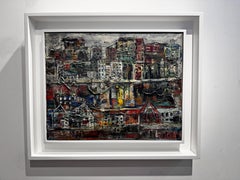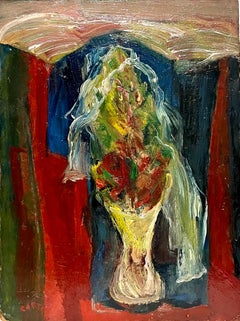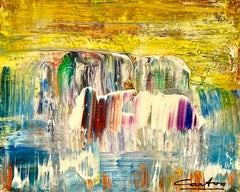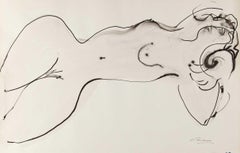Norman Carton
American, 1908-1980
Norman Carton was an American artist and educator known for Abstract Expressionist works in oil on canvas. While this was his most recognized style and medium, Carton was primarily a colorist and also worked as a muralist, classically trained portrait and landscape artist, sculptor, theater set and fabric designer, and illustrator as well as in a variety of abstractions. He has a large museum collection and commercial history, showing in more than 20 solo and 135 group exhibitions."
He was awarded numerous awards, prizes and fellowships for painting. In the 1930s he was part of the WPA creating murals. In the 1940s, he founded a fabric design and production firm which was featured in Interiors magazine, Vogue, Harper's Bazaar, and Women's Wear Daily. These were hand-printed fabrics and his clients were Nina Ricci, Hattie Carnegie, Lord & Taylor, and others. In 1962 Norman Carton opened his own Dewey Gallery in NYC.
Carton's works continue to be included in present day exhibitions including at Quogue Gallery entitled 1950s and 1960s Works on Paper,, at the Nassau County Museum of Art entitled Blue in 2020 as well as Energy: The Power of Art in 2019, and at the Anita Shapolsky Gallery in 2019 entitled Inspiration & Exploration.
Norman Carton's 2020 solo exhibition at Quogue Gallery was reviewed by Charles A Riley. A representational portion of Carton's papers which include correspondence, writings, notes, exhibition catalogs and sketchbooks were donated to the Smithsonian Archives of American Art where they remain.| Average Sold Price |
| $775 |
| Styles |
| Materials |
| Related Artists |
American Vivid Abstract Expressionist Art Oil Painting Norman Carton, WPA Artist
By Norman Carton
Located in Surfside, FL
Norman Carton (1908 – 1980) was an American artist and educator known for abstract expressionist art. He was born in the Ukraine region of Imperial Russia and moved to the United States in 1922 where he spent most of his adult life.
A classically trained portrait and landscape artist, Carton also worked as a drafter, newspaper illustrator, muralist, theater set designer, photographer, and fabric designer and spent most of his mature life as an art educator. Carton showed in and continues to be shown in many solo and group exhibitions. His work is included in numerous museums and private collections throughout the world.
Norman Carton was born in the Dnieper Ukraine territory of the Russian Empire in 1908. Escaping the turbulence of civil war massacres, he settled in Philadelphia in 1922 after years of constant flight. While attending the Pennsylvania Museum School of Industrial Art, Carton worked as a newspaper artist for the Philadelphia Record from 1928 to 1930 in the company of other illustrator/artists who had founded the Ashcan School, the beginnings of modern American art. From 1930 to 1935, he studied at the Pennsylvania Academy of Fine Arts under Henry McCarter, who was a pupil of Toulouse-Lautrec, Puvis de Chavanne, and Thomas Eakins. Arthur Carles, especially with his sense of color, and the architect John Harbison also provided tutelage and inspiration. Following his time at the Pennsylvania Academy of Fine Arts, Carton studied at the Barnes Foundation from 1935 to 1936 where he was influenced by an intellectual climate led by visiting lecturers John Dewey and Bertrand Russell as well as daily access to Albert C. Barnes and his art collection.
Carton was awarded the Cresson Traveling Scholarship in 1934 which allowed him to travel through Europe and study in Paris. There he expanded his artistic horizons with influences stemming from Henri Matisse, Pablo Picasso, Chaim Soutine, and Wassily Kandinsky. While at the Pennsylvania Academy of Fine Arts, Carton was also awarded the Toppan Prize for figure painting as well as the Thouron Composition Prize. He received numerous commissions as a portrait artist, social realist, sculptor, and theatrical stage designer as well as academic scholarships. During this time, Carton worked as a scenery designer at Sparks Scenic Studios, a drafter at the Philadelphia Enameling Works, and a fine art lithographer.
From 1939 to 1942, the Works Progress Administration (WPA) Federal Art Project employed Carton as a muralist and easel artist. He collaborated with architect George Howe. The WPA commissioned Carton to paint major murals at the Helen Fleischer Vocational School for Girls in Philadelphia, the Officers’ Club at Camp Meade Army Base in Maryland, and in the city of Hidalgo, Mexico. Throughout the 1940s, Carton exhibited and won prizes for his semi-abstract Expressionist and Surrealist paintings. He socialized with and was inspired by Émile Gauguin and Fernand Leger. During World War II, Carton was a naval structural designer and draftsman at the Cramps...
Category
Mid-20th Century Abstract Expressionist Norman Carton
Materials
Canvas, Oil
Mid Century Modern abstract cityscape, unique oil painting, signed twice, Framed
By Norman Carton
Located in New York, NY
Norman Carton
Mid Century Modern Cityscape, ca. 1951
Oil on canvas painting (signed twice)
Signed twice: hand signed on the front and also signed on the back
Unique
Frame included:
T...
Category
1950s Expressionist Norman Carton
Materials
Canvas, Oil
$7,900
H 19 in W 23 in D 2.5 in
American Abstract Expressionist Flowers Oil Painting Norman Carton WPA Artist
By Norman Carton
Located in Surfside, FL
Norman Carton (1908 – 1980) was an American artist and educator known for abstract expressionist art. He was born in the Ukraine region of Imperial Russia and moved to the United States in 1922 where he spent most of his adult life.
A classically trained portrait and landscape artist, Carton also worked as a drafter, newspaper illustrator, muralist, theater set designer, photographer, and fabric designer and spent most of his mature life as an art educator. Carton showed in and continues to be shown in many solo and group exhibitions. His work is included in numerous museums and private collections throughout the world.
Norman Carton was born in the Dnieper Ukraine territory of the Russian Empire in 1908. Escaping the turbulence of civil war massacres, he settled in Philadelphia in 1922 after years of constant flight. While attending the Pennsylvania Museum School of Industrial Art, Carton worked as a newspaper artist for the Philadelphia Record from 1928 to 1930 in the company of other illustrator/artists who had founded the Ashcan School, the beginnings of modern American art. From 1930 to 1935, he studied at the Pennsylvania Academy of Fine Arts under Henry McCarter, who was a pupil of Toulouse-Lautrec, Puvis de Chavanne, and Thomas Eakins. Arthur Carles, especially with his sense of color, and the architect John Harbison also provided tutelage and inspiration. Following his time at the Pennsylvania Academy of Fine Arts, Carton studied at the Barnes Foundation from 1935 to 1936 where he was influenced by an intellectual climate led by visiting lecturers John Dewey and Bertrand Russell as well as daily access to Albert C. Barnes and his art collection.
Carton was awarded the Cresson Traveling Scholarship in 1934 which allowed him to travel through Europe and study in Paris. There he expanded his artistic horizons with influences stemming from Henri Matisse, Pablo Picasso, Chaim Soutine, and Wassily Kandinsky. While at the Pennsylvania Academy of Fine Arts, Carton was also awarded the Toppan Prize for figure painting as well as the Thouron Composition Prize. He received numerous commissions as a portrait artist, social realist, sculptor, and theatrical stage designer as well as academic scholarships. During this time, Carton worked as a scenery designer at Sparks Scenic Studios, a drafter at the Philadelphia Enameling Works, and a fine art lithographer.
From 1939 to 1942, the Works Progress Administration (WPA) Federal Art Project employed Carton as a muralist and easel artist. He collaborated with architect George Howe. The WPA commissioned Carton to paint major murals at the Helen Fleischer Vocational School for Girls in Philadelphia, the Officers’ Club at Camp Meade Army Base in Maryland, and in the city of Hidalgo, Mexico. Throughout the 1940s, Carton exhibited and won prizes for his semi-abstract Expressionist and Surrealist paintings. He socialized with and was inspired by Émile Gauguin and Fernand Leger. During World War II, Carton was a naval structural designer and draftsman at the Cramps...
Category
Mid-20th Century Abstract Expressionist Norman Carton
Materials
Oil, Board
American Vivid Abstract Expressionist Art Oil Painting Norman Carton, WPA Artist
By Norman Carton
Located in Surfside, FL
Norman Carton (1908 – 1980) was an American artist and educator known for abstract expressionist art. He was born in the Ukraine region of Imperial Russi...
Category
Mid-20th Century Abstract Expressionist Norman Carton
Materials
Canvas, Oil
Nude Study (1)
By Norman Carton
Located in Columbia, MO
Norman Carton
Norman Carton (Russian American, 1908–1980), a vibrant force in Abstract Expressionism, was known for his dynamic use of color and expressive, gestural brushwork. Born...
Category
20th Century Abstract Norman Carton
Materials
Paper, Ink
Untitled
By Norman Carton
Located in Austin, TX
Waterline Fine Art, Austin, TX is pleased to present the following work:
Oil on canvas. Signed lower right, signed and sequentially numbered on verso.
44 x 30.25 in.
47.5 x 33.75 in. (framed)
Custom framed in a two-tiered matte white hardwood tray frame.
Provenance
Estate of Norman Carton
Norman Carton was born in the Ukraine, eventually immigrating to the U.S. in 1922 and settling in Philadelphia, where he attended the Pennsylvania Museum School of Industrial Art. In the 1930s, he received a scholarship to attend the Pennsylvania Academy of Fine Arts (PAFA).
Between 1939 and 1942, the Works Project Administration (WPA) employed Carton as a muralist. During World War II, Carton was a naval structural designer and draftsman at the Cramps...
Category
1970s Abstract Expressionist Norman Carton
Materials
Canvas, Oil
Nude Study (4)
By Norman Carton
Located in Columbia, MO
Norman Carton
Norman Carton (Russian American, 1908–1980), a vibrant force in Abstract Expressionism, was known for his dynamic use of color and expressive, gestural brushwork. Born...
Category
20th Century Abstract Norman Carton
Materials
Paper, Ink
Untitled
By Norman Carton
Located in Columbia, MO
Norman Carton
Norman Carton (Russian American, 1908–1980), a vibrant force in Abstract Expressionism, was known for his dynamic use of color and expressive, gestural brushwork. Born...
Category
20th Century Abstract Norman Carton
Materials
Canvas, Oil
Browse all Art from Norman Carton
Shop NowNorman Carton Sale Prices
This data represents a recent sample of sales made on 1stDibs during the specified years. All sales are anonymized.
| Sold Date | Sold Price | Category | Medium | Creation Year | |
|
| $775 |
Average sold price of items in the past 12 months |
| $775-$775 |
| Sold price range of items in the past 12 months |
Artists Similar to Norman Carton
Norman Carton art for sale on 1stDibs.
Find a wide variety of authentic Norman Carton available for sale on 1stDibs. If you’re browsing the collection of art to introduce a pop of color in a neutral corner of your living room or bedroom, you can find work that includes elements of red and other colors. You can also browse by medium to find art by Norman Carton in oil paint, paint, canvas and more. Much of the original work by this artist or collective was created during the 20th century and is mostly associated with the abstract style. Not every interior allows for large Norman Carton, so small editions measuring 6 inches across are available. Customers who are interested in this artist might also find the work of Jay Milder, Monica Angle, and Edward Avedisian. Norman Carton prices can differ depending upon medium, time period and other attributes. On 1stDibs, the price for these items starts at $1,196 and tops out at $45,000, while the average work can sell for $2,800.







